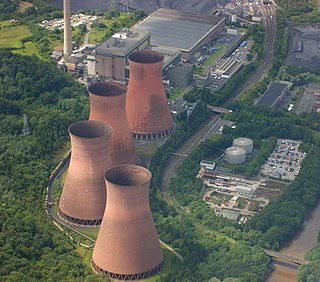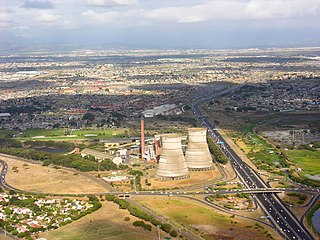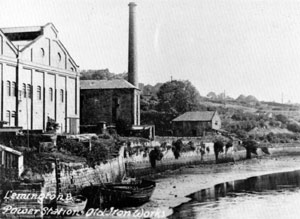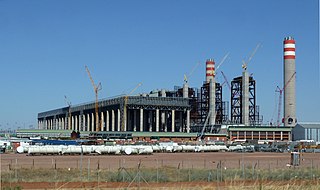
Bankside Power Station is a decommissioned electricity generating station located on the south bank of the River Thames, in the Bankside area of the Borough of Southwark, London. It generated electricity from 1891 to 1981. It was also used as a training base for electrical and mechanical student apprenticeships from all over the country. Since 2000 the building has been used to house the Tate Modern art museum and gallery.

The Ironbridge power stations refers to a series of two power stations that occupied a site on the banks of the River Severn at Buildwas in Shropshire, England. The Ironbridge B Power Station was operated by E.ON UK but the site is now owned by Haworth Group. The station stands near the Ironbridge Gorge World Heritage Site. Originally powered by coal, they were converted to use 100% biomass fuel. Ironbridge B Power Station stopped generating electricity on 20 November 2015, with the decommissioning process continuing into 2017. The main phase of the 27-month demolition process began at 11:00 GMT on 6 December 2019, commencing with the four cooling towers.

Athlone is a suburb of Cape Town located to the east of the city centre on the Cape Flats, south of the N2 highway. Two of the suburb's main landmarks are Athlone Stadium and the decommissioned coal-burning Athlone Power Station. Athlone is mainly residential and is served by a railway station of the same name. It however includes industrial and commercial zones. There are many "sub-areas" within Athlone, including Gatesville, Rylands, Belgravia Estate, Bridgetown and Hazendal. Colloquially other areas around Athlone are also often included in the greater Athlone area even though the City of Cape Town might classify them as separate neighborhoods such as Rondebosch East, Crawford, and Manenberg.

The Ferrybridge power stations were a series of three coal-fired power stations on the River Aire near Ferrybridge in West Yorkshire, England, in operation from 1927 to 2016 on a site next to the junction of the M62 and A1(M) motorways.

Didcot power station is an active natural gas power plant that supplies the National Grid. A combined coal and oil power plant, Didcot A, was the first station on the site which opened in 1970 and was demolished between 2014 and 2020. The power station is situated in Sutton Courtenay, near Didcot in Oxfordshire, England. Additionally Didcot OCGT is a gas-oil power plant, originally part of Didcot A and now independent that continues to provide emergency backup power for the National Grid.

Drakelow Power Station refers to a series of three now decommissioned and demolished coal-fired power stations located 2.4 mi (3.9 km) south of Burton upon Trent, Staffordshire in the West Midlands of England, on the River Trent. However, the station was actually located in the county of Derbyshire, in the East Midlands. The power station was a distinguishable landmark of Burton, which is most famous for its breweries.

Kearsley Power Station was a coal-fired power station in Stoneclough, near Kearsley, Bolton, England. It was designed in 1927 by Dr H.F. Parshall for the Lancashire Electric Power Company. The original installation was known as Kearsley 'A', comprising two British Thomson-Houston (B.T.H.) turbo-alternators rated at 32.25 megawatts each. Further extensions became Kearsley 'B' (1936/38), with two more B.T.H. turbo-alternators each capable of producing 51.6 megawatts. Finally Kearsley 'C' (1949) was completed with two more B.T.H. machines rated at 52 megawatts each. The station closed in 1980 when only 'B' station remained operational. The 5 cooling towers were demolished during the week of 14 May 1985.

Lemington Power Station was a small, now demolished coal-fired power station, located in North East England. It was situated on the Lemington Gut, a backwater of the River Tyne, at Lemington, 3.5 mi (5.6 km) west of Newcastle upon Tyne. The station's main building stood until 2017 as a rare example of an early power station, dating from before the nationalisation of the United Kingdom's electrical supply industry.

The Stella power stations were a pair of now-demolished coal-fired power stations in the North East of England that were a landmark in the Tyne valley for over 40 years. The stations stood on either side of a bend of the River Tyne: Stella South power station, the larger, near Blaydon in Gateshead, and Stella North power station near Lemington in Newcastle. Their name originated from the nearby Stella Hall, a manor house close to Stella South that by the time of their construction had been demolished and replaced by a housing estate. They operated from shortly after the nationalisation of the British electrical supply industry until two years after the Electricity Act of 1989, when the industry passed into the private sector.
The Rugeley power stations were a series of two coal-fired power stations located on the River Trent at Rugeley in Staffordshire. The first power station on the site, Rugeley A power station was opened in 1961, but has since been closed and demolished. Rugeley B power station was commissioned in 1970, and closed on 8 June 2016. The cooling towers of which were demolished on 6 June 2021. It had an output of 1,000 megawatts (MW) and had a 400 kilovolt (kV) connection to the national grid. The B station provided enough electricity to power roughly half a million homes.

Ince Power Station refers to two demolished power stations near Ellesmere Port in Cheshire, North West England.

Medupi Power Station is a Dry-cooled coal-fired power station built by Eskom near Lephalale in Limpopo province, South Africa. The station consists of 6 generating units with a nameplate capacity of 800 MW each bringing the total installed capacity of 4,800 MW.

Hams Hall Power Station refers to a series of three, now demolished coal-fired power stations, situated in Warwickshire in the West Midlands of England, 9 miles (14 km) from Birmingham.

Darlington power station refers to a series of two coal-fired power stations situated in Darlington in County Durham, North East England.
Meaford Power Station was a coal-fired power station situated on the River Trent at Meaford near Stone in Staffordshire.

Orlando Power Station is a decommissioned coal-fired power station in Soweto, South Africa. The power station was commissioned at the end of the Second World War and served Johannesburg for over 50 years.

Kirkstall power station was a coal-fired unit opened in 1930, serving the city of Leeds, West Yorkshire, England.

Skelton Grange Power Station refers to two now-demolished coal fired power stations that served the city of Leeds and surrounding areas. They were located in the Stourton area of the city. The power stations were built in the early 1950s and early 1960s, taken out of use in 1983 and 1994 and subsequently dismantled but the associated 275 kV switching substation was retained and remains in use.
Goldington Power Station was a 180 MW coal-fired electricity generating station located to the east of Bedford in Bedfordshire, England. It was commissioned in 1955 and closed in 1983 and was demolished during 1984–87.
Blackburn power stations are a series of electricity generating stations that have provided electric power to the town of Blackburn and the wider area from 1895 to the present. The first station in Jubilee Street, Blackburn began operating in 1895. A new larger station known as Blackburn East or Whitebirk power station was commissioned in 1921 and was rebuilt in stages over the period 1942 to 1955. Whitebirk station closed in 1976. The 60 MW Blackburn Mill Combined Cycle Gas Turbine (CCGT) power station has generated electricity since 2002. The Blackburn energy from waste (EfW) plant is currently (2020) being planned.



















